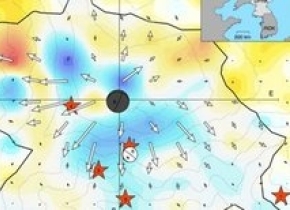

科学家们将雷达信息添加到地震数据、同位素测量和光学图像中来研究隐蔽的核试验。克里斯托弗·因塔利亚塔报道。
撰文\播音:克里斯托弗·因塔利亚塔(Christopher Intagliata)
翻译:邱燕宁
审校:杨枭
North Korea has promised to close its underground nuclear test site at Mount Mantap later this month. Shortly thereafter, President Trump is set to meet North Korea's leader Kim Jong-un in Singapore.
朝鲜已承诺在本月晚些时候,关闭在曼塔山地下的核试验场。此后不久,特朗普总统将在新加坡与朝鲜领导人金正恩会面。
Regardless of how that goes, there’s a now an additional tool to investigate covert subterranean tests: radar. Specifically, a type called synthetic aperture radar, which works day and night, and through clouds.
无论如何,现在有了一种另外一种工具,它可以调查隐蔽的地下试验装置,这就是雷达。具体来说,是一种叫作合成孔径雷达的仪器,它可以在白天和黑夜甚至穿透云层工作。
Scientists already use seismic data in their nuclear detective work. "We use the kind of techniques that earthquake seismologists use to figure some aspect of what that explosion did." Roland Bürgmann, a geophysicist at University of California, Berkeley. He says they can also measure isotopes in the air, as well as optical images pre- and post-explosion.
科学家们已经在他们的核侦察工作中使用了地震数据。“我们通过使用地震学家使用的技术来研究爆炸的一些情况。”加州大学伯克利分校的地球物理学家罗兰·比尔曼(Roland Bürmann)说,他们还可以测量空气中的同位素,以及获取爆炸前后的光学图像。
Now Bürgmann and his team have used synthetic aperture radar data from German and Japanese satellites to gather more clues about North Korea's biggest blast, in September 2017. Comparing before and after scans of the test site, their analysis found that the mountain bulged a dozen feet in one direction, and sunk a foot and a half.
Using computational modeling, they then simulated what sort of blasts could have produced those movements. Their estimate: the blast was at least six times as strong as the bomb the U.S. dropped on Nagasaki in World War II. The details are in the journal Science. [Teng Wang et al., The rise, collapse, and compaction of Mt. Mantap from the 3 September 2017 North Korean nuclear test]
现在,比尔曼和他的团队已经通过使用德国和日本卫星的合成孔径雷达,收集了有关2017年9月发生的朝鲜最大(核)爆炸的更多线索。通过比较核实验地点前后的扫描结果,他们分析发现,该山在一个方向上,隆起了十几英尺,(整体)下沉了一英尺半。然后他们使用计算机建模,来模拟可以产生如此运动的爆炸。他们估计:爆炸至少是美国在二战期间投掷在长崎上的炸弹强度的六倍。详情请见《科学》Science杂志。
"I think our study shows this is an especially valuable observation that can be thrown into the mix." When the U.S. and India launch their synthetic aperture radar satellite, called NISAR, in 2020, we'll have even more of this new kind of data. The hope is that no unauthorized nuclear tests will take place to be discovered.
“我认为我们的研究是一个特别有价值的观察结果,可以帮助进行综合研究。”当美国和印度在2020年发射合成孔径雷达卫星NIDAR时,我们将拥有更多这种新的数据。希望不会发生未经许可的核试验。
—Christopher Intagliata
 京公网安备11010502039775号
京公网安备11010502039775号